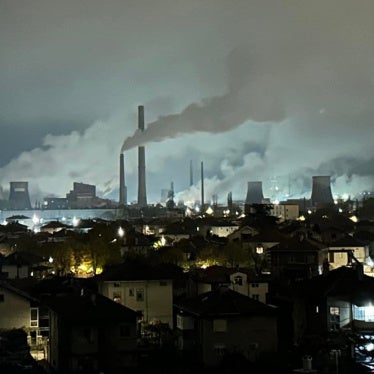The body of a man showing signs of torture was recovered by his relatives in western Uzbekistan eight days after his arrest, Human Rights Watch said today. It was the fourth such incident in the country this year.
On December 9, relatives buried Kamalodin Jumaniazov, whose body they had received from police custody two days earlier. Witnesses who viewed the body told Human Rights Watch that it had two bloody injuries on the forehead, bruising on the nape of the neck, and a grazed knee. Photographs shown to Human Rights Watch confirm these injuries.
News of the death came as many await the Uzbek government’s release of a promised national plan of action to combat torture.
“The Uzbek government must conduct a thorough and independent investigation into this death,” said Rachel Denber, acting director of Human Rights Watch’s Europe and Central Asia Division. “The government claims to be taking steps to combat torture, but once again the reality of the situation sadly shows otherwise.”
Police in a village in Karakalpakstan, in western Uzbekistan, arrested Jumaniazov, a 25-year old father of two, on November 29 on suspicion of theft. The prosecutor’s office on December 1 issued an arrest warrant, accusing him of marijuana use. On December 7, after hearing rumors of Jumaniazov’s death, his family went to the police station, where they were told to go to the morgue. At the morgue, officials showed them Jumaniazov’s already frozen body. He had apparently died at least 15 hours earlier.
The next day, when the family was preparing the corpse for burial, they noticed the injuries on the body and called various law enforcement offices. A prosecutor from the Turkul district prosecutor’s office told Jumaniazov’s relatives that he had committed suicide by hanging himself in his cell with a sweater.
Those who saw the body said that the throat had been cut in the autopsy and that injuries to the front of the neck were therefore not visible. The forearms of the corpse also had cuts across them, but a doctor told the family that it appeared that these had been made after Jumaniazov’s death.
On December 8, the family demanded that a forensic expert examine the body. The prosecutor’s office brought in two experts who orally confirmed to family members that Jumaniazov had suffered from head trauma. The experts refused to put their findings in writing, however, and representatives from the prosecutor’s office prohibited Jumaniazov’s relatives from recording the experts or the body on video.
According to Jumaniazov’s family members, authorities have not opened an investigation into his death.
“Uzbekistan has a poor record on holding torturers accountable. Let’s hope that this case will be the exception,” said Denber. “The government should finally take on this issue, and prove that all its talk of reform has some substance.”
In Bukhara, Human Rights Watch recently documented another suspicious death in custody. On August 1 police in Bukhara province detained Nodirjon Zamonov, 20, on suspicion of theft. When his father went to the police station that afternoon, he saw his son terrified and crying. His father left the police station at approximately 2 p.m. An hour later, the family found their son dead on the floor of their cowshed, with his neck encircled by a rope that did not belong to the family, and with bruises and other wounds on his body.
The Bukhara police are in possession of a handwritten letter of confession for the theft, allegedly signed by Zamonov, although the family stated that the handwriting is not his.
Police claim that Zamonov hanged himself. However, the family said that although there was a rope hanging over Zamonov’s body when they found him, he was not hanging. Photographic evidence and the family members’ description of the throat injury appear to be inconsistent with suicide by hanging.
The prosecutor’s office opened an investigation into Zamonov’s death, but soon closed it, stating that there was no evidence of a crime. The death certificate stated that the cause of death was unknown.
The United Nations Special Rapporteur on Torture visited the country at the end of 2002 and in April issued a report finding that torture was systematic in Uzbekistan. Earlier this year the Uzbek government drafted a national action plan to implement the Special Rapporteur’s recommendations to combat torture. International interlocutors in this process expected a final draft of the plan by mid-November, but the government has not yet issued it.






